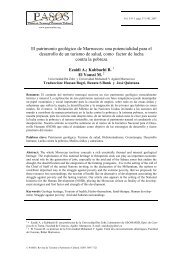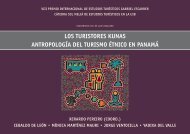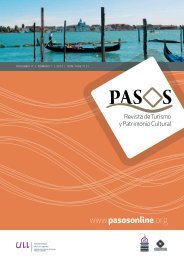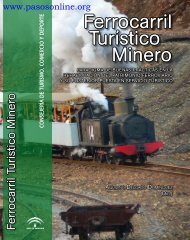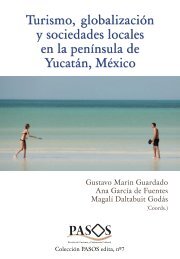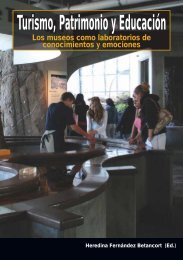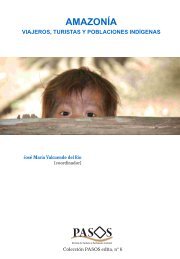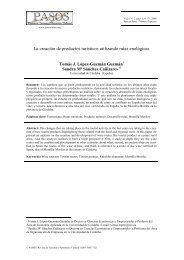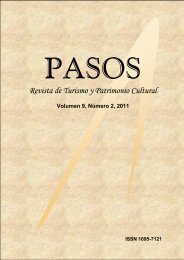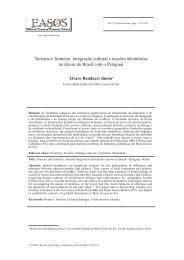Post Hoc Tourist Segmentation with Conjoint and Cluster ... - Pasos
Post Hoc Tourist Segmentation with Conjoint and Cluster ... - Pasos
Post Hoc Tourist Segmentation with Conjoint and Cluster ... - Pasos
You also want an ePaper? Increase the reach of your titles
YUMPU automatically turns print PDFs into web optimized ePapers that Google loves.
Sérgio Dominique Ferreira Lopes, Antonio Rial Boubeta <strong>and</strong> Jesús Varela Mallou 499<br />
<strong>Cluster</strong>s<br />
Gender Chi-square 13,234<br />
df 4<br />
Sig. ,010<br />
Occupation Chi-square 1,487<br />
df 4<br />
Sig. ,829<br />
Incomings Chi-square 14,769<br />
df 20<br />
Sig. ,789<br />
Civil status Chi-square 5,331<br />
df 8<br />
Sig. ,722<br />
Age Chi-square 10,542<br />
df 8<br />
Sig. ,229<br />
Table 4. Pearson’s Chi-square values<br />
Conclusions<br />
Tourism is a key sector of growth in<br />
some countries (such is the case of Portugal).<br />
It has an enormous weight on the<br />
Gross Domestic Product (about 10%) <strong>and</strong> it<br />
generates about 10% of the national employment.<br />
In the current <strong>and</strong> competitive<br />
environment, managing tourism resources<br />
of a country under a marketing approach is<br />
very important <strong>and</strong> it’s a key to success.<br />
Factors like the enormous competitiveness<br />
<strong>and</strong> dynamism of the tourism sector, the<br />
appearance of new destinations, the enormous<br />
globalization <strong>and</strong> the international<br />
crisis affect negatively the most part of<br />
tourist destinations. So, new adjustments<br />
must be realized in order to remain competitive.<br />
This way, it’s necessary to invest<br />
in a “Research <strong>and</strong> Development” strategy<br />
as it’s invested in quality of hotels <strong>and</strong> restaurants<br />
<strong>and</strong> in national <strong>and</strong> international<br />
fairs. To invest in Market Research is very<br />
important <strong>and</strong> it becomes by itself a sustainable<br />
platform for tourism.<br />
In this context, professionals must be<br />
aware of the outset of the consumers’ preferences,<br />
needs, habits <strong>and</strong> lifestyles that<br />
are more <strong>and</strong> more heterogeneous, which<br />
generates a tremendous diversification of<br />
supply. As such, focusing on methodologies<br />
that allow optimizing the management of<br />
tourism resources is an added value.<br />
USA, Spain <strong>and</strong> France are the most<br />
competitive countries in the world <strong>and</strong> they<br />
share a competitive advantage when it<br />
comes to analyzing the preferences of tourists:<br />
the use of <strong>Conjoint</strong> Analysis to know<br />
the real structure of preferences of tourists<br />
(Varela, Rial & García. 2003). In this way,<br />
they can design new strategies that better<br />
suit tourists’ preferences. This worldwide<br />
competitiveness led to a tremendous diversification<br />
of the supply of products <strong>and</strong> services,<br />
that’s because it’s so important to<br />
know the consumers’ preferences.<br />
So, from a methodological point of view<br />
the present article illustrates the enormous<br />
potential that the combined use of the <strong>Conjoint</strong><br />
Analysis <strong>and</strong> the <strong>Cluster</strong> Analysis has<br />
in the management of tourism resources. It<br />
shows that the preferences in this sector<br />
are more complex than it might be expected.<br />
More precisely, it has been possible<br />
to identify up to five different segments (in<br />
a seemingly homogeneous population such<br />
as the young residents in Northern Portugal),<br />
each segment <strong>with</strong> a peculiar structure<br />
of preferences. The characterization of<br />
each group can bring more guide lines to<br />
market researchers in the case of the post<br />
hoc segmentation than in the case of an a<br />
priori segmentation. So, being able to know<br />
accurately the preferences of tourists, segmenting<br />
market properly allows marketing<br />
researchers to identify heterogeneous<br />
groups <strong>and</strong> develop products that suit the<br />
preferences of each group (Picón, Varela &<br />
Lévy, 2004). This is an essential strategy<br />
for the tourism management.<br />
Finally, it would be interesting to have a<br />
more representative sample in order to<br />
know more precisely which the tourist’s<br />
preferences are. And it would be interesting<br />
to carry out a Br<strong>and</strong> Image Analysis <strong>and</strong><br />
Positioning. This way, it would be possible<br />
to know which attributes/characteristics<br />
are related <strong>with</strong> the tourist destinations of<br />
Portugal <strong>and</strong> to know which marketing<br />
strategies should be created to suit the<br />
diversity of the national <strong>and</strong> international<br />
tourists’ preferences.<br />
References<br />
Baloglu, S. & McCleary, K.W.<br />
1999 “A model of destination image formation”,<br />
Annals of Tourism Research, 35<br />
(4): 11-15.<br />
PASOS. Revista de Turismo y Patrimonio Cultural, 7(3). 2009 ISSN 1695-7121



